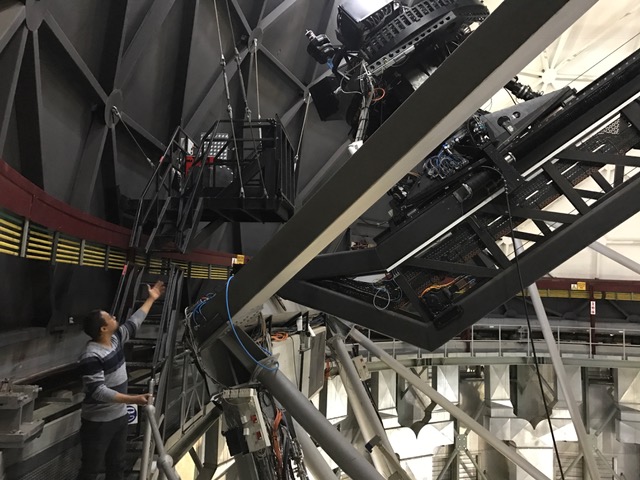Having a look at the SALT tracker: A spherical aberration corrector (SAC) mounted on a tracker beam at the prime focus delivers a high quality image to the focal plane and enables a celestial object to be followed for twelve degrees across the sky.

SALT Tracker and Payload
Published by
Blaine Lomberg
Blaine Lomberg studied Physics from 2005-2008 at the University of the Western Cape. In 2009, he completed an Honours Degree specializing in Nuclear Physics. In 2010, Blaine joined the Accelerator and Engineering Group at iThemba Labs, where he worked on ion source physics focusing on a diagnostic device for ion beam quality measurements. His Master’s thesis was titled, “Studies of an emittance measurement device for beam quality optimisation of ion sources”. From September 2012 -2015, Blaine joined oPAC (optimization of the performance of any Particle Accelerator - FP7 Marie Curie Initial Training Network (ITN) scheme) an EU Consortium as a Marie Curie Fellow and was jointly based at the Cockcroft Institute for Accelerator Science in Daresbury and the University of Liverpool, UK. During his fellowship, Blaine developed advance R&D technology for novel optical instrumentation for particle accelerator diagnostic applications. In July 2016, Blaine joined the SAAO as a PDP (Professional Development Program) fellow, with his research aimed on developing novel instrumentation for observational astronomy; specially focussing on studying exoplanets such as ringed system’s similar to Saturn. His interest includes adaptive optics and optimising imaging systems for overcoming the limitations of conventional telescopes used today. Within the NRF-SAAO collaboration, Blaine is a PhD student with the University of Cape Town working with Dr. Steve Crawford and co-supervision by Prof. Patricia Whitelock. In addition, Blaine enjoys blogging, being active in student outreach, disseminating science and his research to the public and local communities. View all posts by Blaine Lomberg